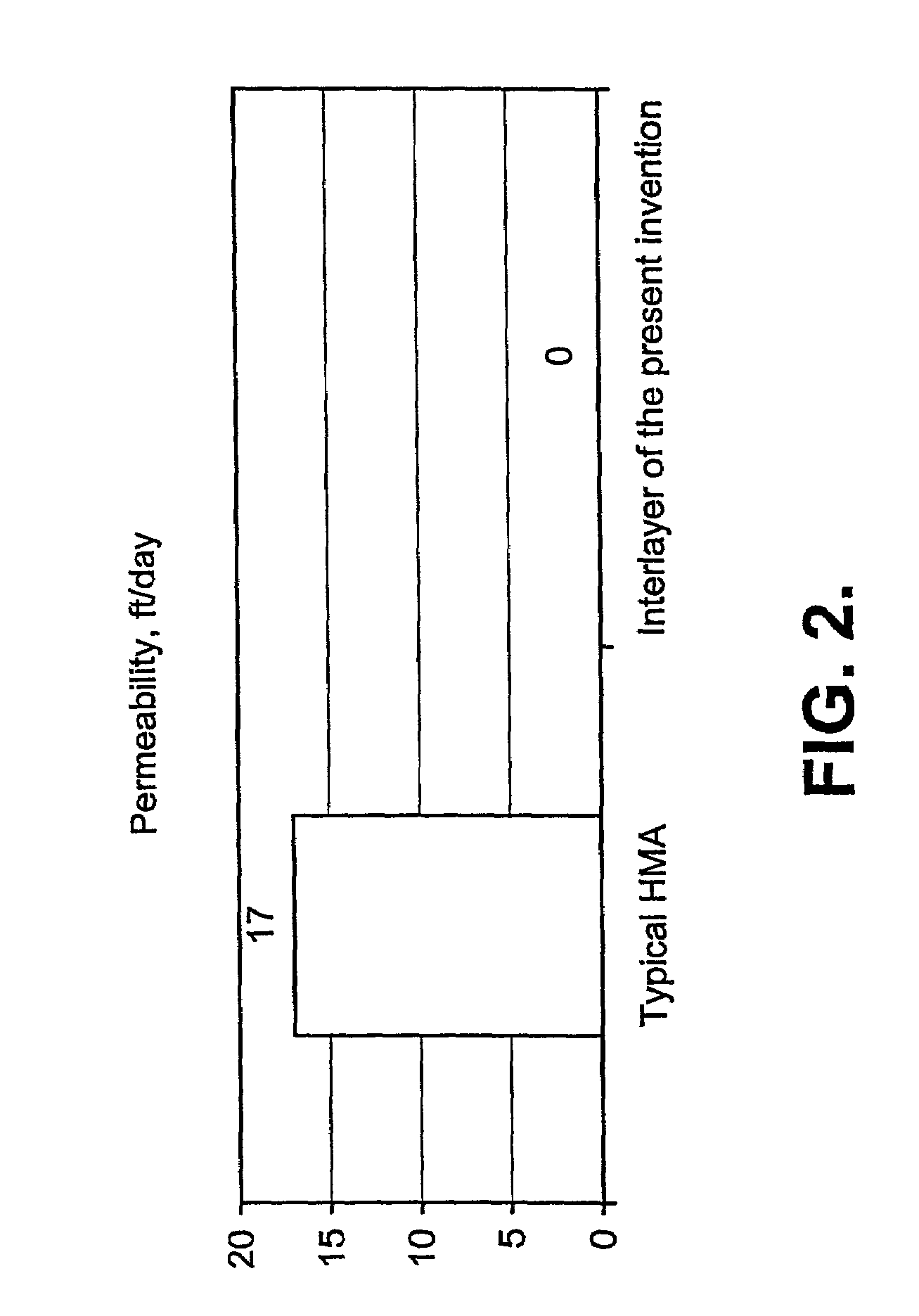Method for selecting an asphalt mixture for making an interlayer and method of making an interlayer
a technology of asphalt mixture and interlayer, which is applied in the field of interlayer, can solve the problems of cracks in the old pavement reflecting through the new overlay, roads created with them, and low strain tolerance, and achieves the effects of reducing the risk of cracking, avoiding cracking, and avoiding cracking
- Summary
- Abstract
- Description
- Claims
- Application Information
AI Technical Summary
Benefits of technology
Problems solved by technology
Method used
Image
Examples
example 1
[0071]A reflective crack relief interlayer system was produced, tested, and placed according to the present invention. The interlayer binder was produced using 93.85% by mass of a base asphalt grading as an AC-5.3% by mass of a polymer based on styrene and a conjugated diene and containing 21% by mass styrene monomer was used. In addition, 3% by mass of a polymer based on styrene and a conjugated diene containing 30% by mass styrene monomer was used. The polymers were added to the asphalt under low shear conditions at a temperature of 180° C. and stirred for a period of 4 hours. At this time the polymers appeared to be dissolved in the asphalt by visual inspection of the blend. To this blend, under low shear blending conditions and at 180° C., was added 0.15% by mass of elemental sulfur to effect vulcanization of the polymer in the asphalt. The blend was allowed to stir under these conditions for 2 hours at which time a homogeneous polymer modified binder was achieved.
[0072]The poly...
example 2
[0076]A reflective crack relief interlayer system was produced, tested, and placed according to the present invention. On Kansas US 75 in Beto Junction, Kans., an interlayer was place over a PCC pavement in stable condition. The binder described in Example 1 was used to make the interlayer in Example 2. Refer to Table 9 for design details.
[0077]
TABLE 9AGGREGATE GRADATIONS - INDIVIDUAL AND BLENDAGG 1AGG 2AGG 3AGG 4% In Blend21.07.043.029.0100.0SIEVEBlendSpecs⅜″9.50 100.0100.0100.0100.0100.0100.0mm#44.75 99.599.884.099.993.0 80-100mm#82.36 81.462.658.098.474.960-85mm#161.18 50.434.242.092.357.940-70mm#300.60027.717.532.063.539.225-55mm#500.30014.210.925.010.817.715-35mm#1000.1505.98.721.00.310.9 6-71mm#2000.0752.37.918.00.18.8 6-14mmAggregate Gsb2.5662.4972.5432.6002.561Fine Aggregate42.0AngularitySand97.080.042.0100.061.8EquivalencyMeth. Blue1.86.53.02.8F & E12.012.0Water2.972.843.200.180.54Absorption
example 3
[0078]A reflective crack relief interlayer system was produced, tested, and placed according to the present invention. The interlayer binder was produced using 65.7% by mass of a base asphalt grading as an AC-30. To this was added 28.15% by mass of an asphalt flux to soften the AC-30, resulting in a final AC blend with a grading approximately equal to an AC-10. 3% by mass of a polymer based on styrene and a conjugated diene and containing 15% by mass styrene monomer was used. An additional 3% by mass of a polymer based on styrene and a conjugated diene and containing 30% by mass total styrene was also used. The polymers were added to the asphalt under low shear conditions at a temperature of 180° C. and stirred for a period of 5 hours. At this time the polymers appeared to be dissolved in the asphalt by visual inspection of the blend. To this blend, under low shear blending conditions and at 180° C., was added 0.15% by mass of elemental sulfur to effect vulcanization of the polymer ...
PUM
| Property | Measurement | Unit |
|---|---|---|
| Temperature | aaaaa | aaaaa |
| Temperature | aaaaa | aaaaa |
| Temperature | aaaaa | aaaaa |
Abstract
Description
Claims
Application Information
 Login to View More
Login to View More - R&D
- Intellectual Property
- Life Sciences
- Materials
- Tech Scout
- Unparalleled Data Quality
- Higher Quality Content
- 60% Fewer Hallucinations
Browse by: Latest US Patents, China's latest patents, Technical Efficacy Thesaurus, Application Domain, Technology Topic, Popular Technical Reports.
© 2025 PatSnap. All rights reserved.Legal|Privacy policy|Modern Slavery Act Transparency Statement|Sitemap|About US| Contact US: help@patsnap.com


